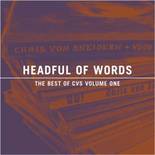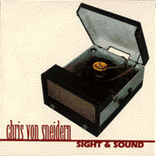|
It’s said you have your whole life to make your first album. I suppose it took about four years, actually, making demos and writing, eventually putting all the “demos” together as Sight & Sound, my debut CD. It started in a rented flat in SF with my buddies from Syracuse, recording on a TEAC 4-track, then in 1991 I found an affordable Deadhead house in the Castro district. I set up a primitive studio in the spare room I had in the basement, the departing roommate was a personal trainer and stored his vitamins in there. The house was a foreclosure bargain and my landlord was invisible. I found out later that the previous owner or his boyfriend had hanged himself from the furnace exhaust pipe near the ceiling. With little sound isolation treatment, I set about recording my songs day and night with new friends Bennett Bowman and Pete Straus, the band somehow named the Pop Gem Factory. The cops were called from time to time, sometimes by my upstairs roommates! I lived on brown rice and yellow onions (calculated to cost $.13), accepting friendly charity or scraping together $7 for a 1200’ reel of ¼” tape, good for four tracks for 16 minutes. I’d mix that four-track to a portable DAT, then transfer that onto a new tape, bouncing internally or mixing that to another DAT dub, etc. It was a tedious process that forced me to plan what I wanted BEFORE I started, unlike today with Pro Tools, when the decisions are made all at once at the end.
Pete was studying to be a shrink, Bennett was smoking pot, playing hoops and recording some music; we’d meet at my Ord St house to bash out whatever new songs I had, as well as rehearsing for shows. Bennett liked to read the paper while playing the drums, or kept a Tower Pulse! magazine open on his floor tom. This was mildly annoying, but Pete really hated it. I told Pete I’d just spoken with Tommy Allen, who had offered to make a demo that he could shop for a record contract along with his management deal on offer. This was progress in comparison to what had been happening in my basement, just making tunes. That afternoon we recorded a batch of songs I wanted to try, and Pete thought it’d be fun to cover The Byrds’ “I’d Feel A Whole Lot Better.” First take, it was a little rushed and rough, so Pete wanted to try again, Bennett groused, “naw...naw, it’s just a cover tune, man...” then Pete exploded. All for me, the roommates, the neighbors, and the tape machine, still running, to hear. After Bennett was banished and insulted, I realized that I no longer had a band. However, I did have three days of studio time, courtesy of Tommy Allen, over Thanksgiving weekend 1992. Tommy is in The Flashcubes, a Syracuse pop band from the late ‘70s, and he was producing records in LA. Pete and I drove down there, full of Hollywood wonder and 20-something rock n’ roll desire. We set up in A&M studio A, which is massive. It’s where they filmed the “We Are The World” video. Tommy played drums in the middle of the room, I was hidden in an iso booth the size of a two-car garage, Pete was somewhere else nearby on headphones. Our engineer was Paul Hamingson, who, like Tommy, knew how to get that ‘90s huge drum sound, microphones on 40-foot stands up in the corners of the ceiling. Pro Tools hadn’t arrived yet. The Neve console in studio A was commissioned by George Martin for previous use in England; the NS-10 speakers were powered 1000 watts a side, good imaging, very clear. I settled into the leather couch. Fruit lived in a bowl. Click track in the cans. I’d had my experience in my little home studio, and while I knew the Telefunken ELA M 251E was a rare and awesome mic, going through a Fairchild 670, sounding great on my guitar, nothing had a convincing charm or intimacy coming back through the speakers. I felt it wasn’t my fault, since I wasn’t in charge at all of anything going on...although maybe that was my fault, then. Tommy was hilarious, joking in the studio, yelling out for “One-Take Johnny and his brother Pete!” and “Hurry up and put a solo down, I gotta take a shit!” Studios have always cracked me up, all the time spent on breaks not making music, yet no one goes outside. In the vocal booth, between takes, I noticed that Steven Tyler drew a perfect Aerosmith logo in Sharpie, hidden on the oak molding above the window. I don’t know it was him, but who else would do that?? There was no partying in LA. We had three great days in a fantastic studio, they mixed the songs the week after we went home to SF. It sounded good, it really did sound professional, but the recordings didn’t move me. I used my original version for the album the following year. “Somedays” is an ode to my old roommate Dave Glavin, who had passed away in 1988. He was one of our Syracuse friends living in SF, 27 and full of nutty youthful passion. He would tape-record himself talking in the bathtub, singing along to Like Flies On Sherbert, and recording live shows: Black Athletes, Alex Chilton, the Nuns, Jonathan Richman, Flying Color, to name a few. He was a rare bird, and while conversations in that Russian Hill household were a chaotic flurry of beer, shouting and loud music, we had quiet one-on-one interactions during jobless afternoons. I couldn't easily reconcile our time of youth and his death, writing this song helped find a place for those feelings.
10 Comments
JRK
7/30/2013 04:42:56 pm
I love reading these. You're an awfully good writer, of songs and prose. I truly can't think of anyone but Steven Tyler who would do that. Unless Dionne Warwick had some spare time between "We Are the World" takes. Have you worked with any other drummers who read on the job?
Reply
Pete Straus
7/31/2013 01:59:25 am
I recall the LA session coincided with the Rodney King riots. One of the engineers at A&M had a Glock in his pocket!
Reply
LC
7/31/2013 02:15:07 am
HA! Poor Bennett. Good song. As always.
Reply
Tommy
7/31/2013 08:10:12 am
.......sounds pretty great!
Reply
Tommy
7/31/2013 08:28:32 am
.....ps, they both sound great, and your story was a fun read that brought back fond memories......I don't know if I ever knew the song was about Dave g.......I'm guessing he'd a liked it very much..........
Reply
cvs
7/31/2013 08:41:49 am
Thanks Tommy, the versions are close cousins for sure, it was good to get that one out again. Another quote of yours I forgot, "That was great...now DOUBLE it!"
Michelle D
8/1/2013 11:36:47 am
Thank for this Chris, love reading your memories because they wake mine. Please, please, please come back to PDX soon!!
Reply
Rob Bayne
8/2/2013 03:54:14 pm
Great song, great backstory.
Reply
tommy
8/9/2013 12:13:30 am
.....cvs, i still say that frequently!
Reply
Your comment will be posted after it is approved.
Leave a Reply. |
CvSChris von Sneidern is a musical artist living in San Francisco. Archives
July 2022
|


 RSS Feed
RSS Feed
